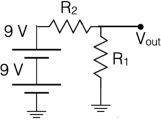Physics 127AL Homework 1 Solution
Hello, dear friend, you can consult us at any time if you have any questions, add WeChat: daixieit
127AL Homework 1 Solution
1 Problem 1
Vout is potential difference between that point and ground, so it’s equal to V1 plus the voltage dropped across R1 :

The only unknown here is the current, which we can calculate by:

so we get for Vout :

2 Problem 2

The three resistors on the left are in parallel, so the resistor with 40kΩ is negligible compared to the other two and their equivalent resistance is about 1kΩ . Similarly, the three resistors in the middle have an equivalent resistance of about 2kΩ .
For the four resistors on the right, 40kΩ is in parallel with 100kΩ, which gives rise to an equivalent resistance of 28.6kΩ . This combination is in series with the 15kΩ resistor, and all of them are in parallel with the 5kΩ resistor. These four resistors as a whole have an equivalent resistance of about 4.5kΩ, although to within 10%, we’d also accept simply 5kΩ .
As a result, the impedance between points A and B is about 1k + 2k + 5k = 8kΩ, or 7.5kΩ if you kept a bit more precision.
3 Problem 3
Since we have an unlimited supply of 9 volt batteries and 3kΩ resistors, to produce a circuit with the given Thevenin equivalent we can use two 9 volt batteries to get 18V, and then use a voltage divider to get the required 12V. As shown below: To get a Thevenin voltage of 12V:


from which we get R1 = 2R2. To get a Thevenin resistance of 4kΩ:

from which we get R1 = 12k and R2 = 6k.
4 Problem 4

Norton current is calculated with the output short-circuited, so:

Norton resistance is the same as Thevenin resistance:

5 Problem 5
Only the voltage source circled in green affects Vout and the potential difference between point A to point B is known to be V. From this, we can tell that as

showed on page 29 of textbook, VTh = ![]() Th =
Th = ![]()
6 Problem 6
We know that the output impedance is just RTh , so the answer is 4kΩ for ![]() .
.
2023-06-16